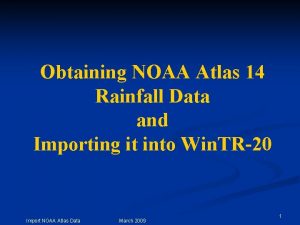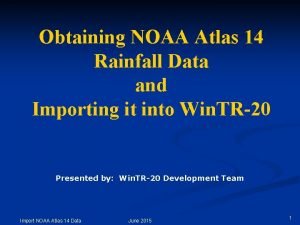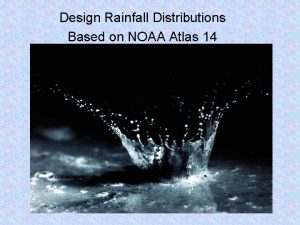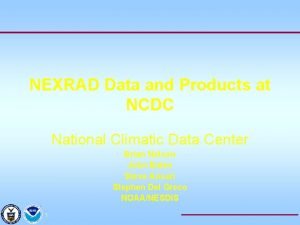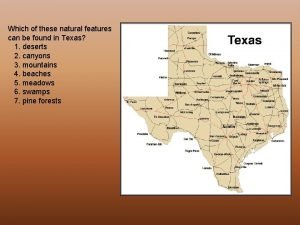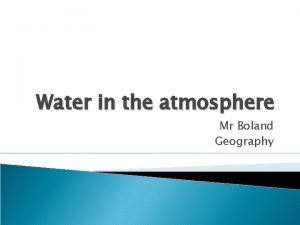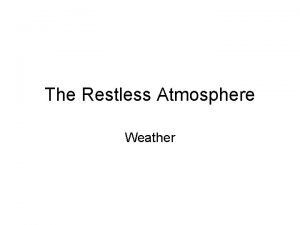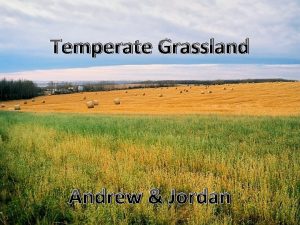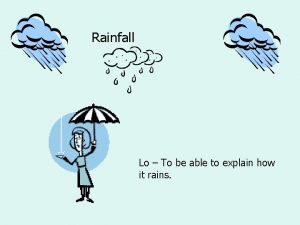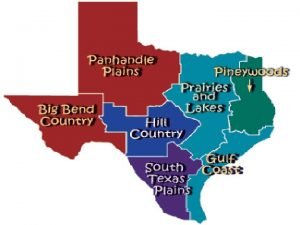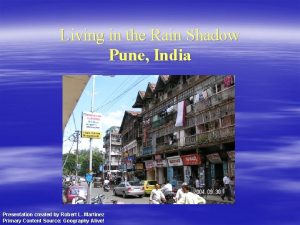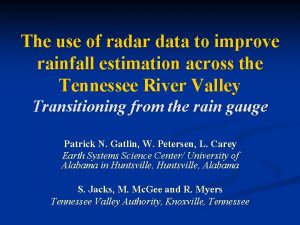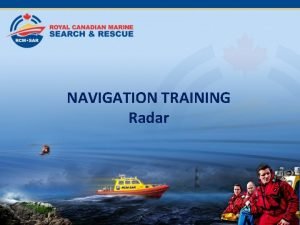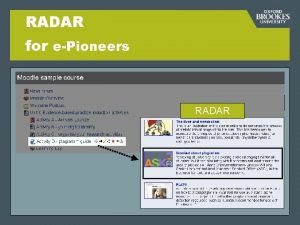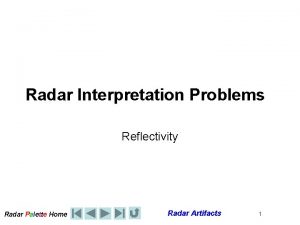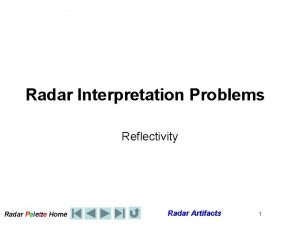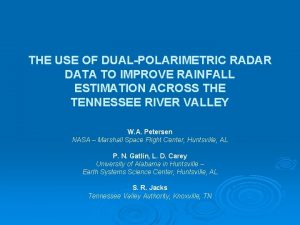The use of radar data to improve rainfall














- Slides: 14

The use of radar data to improve rainfall estimation across the Tennessee River Valley Transitioning from the rain gauge Patrick N. Gatlin, W. Petersen, L. Carey Earth Systems Science Center/ University of Alabama in Huntsville, Alabama S. Jacks, M. Mc. Gee and R. Myers Tennessee Valley Authority, Knoxville, Tennessee

Motivation Reduction of TVA gauge network n Radar rainfall estimation using ARMOR dualpolarimetric radar n Use of UAH infrastructure to “tune” current NEXRAD radars in Tennessee Valley n Prepare dual-pol rainfall algorithms for deployment with NEXRAD upgrade n Support NASA Global Precipitation Measurement Mission n

Advanced Radar for Meteorological and Operational Research n n n Jointly owned by UAH and WHNT Location: HSV, Huntsville, AL C-band Doppler SIGMET RVP 8 and RCP 8 Dual-polarization n Transmits simultaneous H and V Recieves H and V Conventional Doppler Radar T. Schuur Variables Zh, V, W Dual-Polarimetric Doppler Radar Variables obtained: P, Z, V, W, ZDR = 10 log (Zh / Zv), ρhv = correlation between Zh & Zv , ΦDP = Φh – Φv KDP T. Schuur Additional variables ZDR, ΦDP, ρhv, KDP

Rainfall Mapping with ARMOR n H, V return power tells us about drop shape n n Larger rain drops tend to be oblate spheroids Smaller drops spherical Can delineate regions of hail from rain and stratiform vs. convective n Specific differential attenuation (KDP) is good estimator of rainfall Improved rainfall algorithms n adapted from Beard and Chuang (1987)

UAH Rainfall algorithm GOOD DATA? YES NO R = R(ZH) KDP 0. 3 and ZH 35? ICE PRESENT? YES N O ZH BAD? NO R=BAD N O KDP 0. 3 , ZH 35. 0 d. BZ ZDR 0. 5 d. B? YE S (1) R(KDP, ZDR) (2) R(KDP) (3) R(ZH, ZDR) YE S R = R(KDP) YE S R =R(KDP, ZDR) YE S R =R(ZH, ZDR) no KDP< 0. 5? R = R(ZHRAIN) R=BAD N O 1 -hr Accumulation R = R(ZH) R = R(ZH, ZDR) no KDP ≥ 0. 5? YE S N O ZH > 30 d. BZ, ZDR 0. 5 d. B? R > 50 mm/hr, d. BZ > 50 , or Z, ZDR corr. too large ? R = R(KDP) YE S ARMOR RAIN RATE ALGORITHM 6 -hr (N-hr) Accumulation Proprietary information, Walter A. Petersen, University of Alabama Huntsville

Moving away from “point” measurements: Radar Applications for TVA • NEXRAD radar network dual-polarimetric upgrade scheduled for 2009 -2011: improved precipitation estimation a primary driver. • Can rain estimates using the new radar technology (i. e. , dual-polarimetric) replace a significant % of the TVA rain gauge network? • Demonstration project with UAH ARMOR radar in advance of NEXRAD dual-pol upgrade • ARMOR rain rate estimator, NO gauge input • 1 -24 hour rain estimates over basin scales • Real time data and web-products • Facilitate/reintroduce radar precipitation estimation tailored to TVA needs • Future customer specific extensions (e. g. , National Weather Service products, site specific terrain corrections etc. E. g. , Summer season precipitation event Radar rainfall estimates compare favorably to individual rain gauge totals…………… BUT much of the heaviest precipitation missed the rain gauges altogether (this is typical)! Non-uniform nature of the rain field presents problems for rain gauges- but not for radars! Walter A. Petersen, University of Alabama Huntsville

Current TVA gauge network Gauges are sole rainfall input into streamflow model

Replacement of gauges with radar Radar and gauges used as separate rainfall inputs into streamflow model

Rainfall Products Development 6 -Hour Rainfall Accumulation Algorithm and Product development http: //www. nsstc. uah. edu/ARMOR/webimage/ • Centered on ARMOR radar in Huntsville • TVA Basins and 25 km range rings indicated with white contours. • TVA gauge locations indicated as points • Creation of simple numeric table summarizing basin mean rainfall statistics (area mean, maximum, minimum and standard deviation of 1 km pixels in each basin). • ASCII or net. CDF Data files available on demand (can modify formats and integration times as needed) • ASCII now distributed to TVA automatically

Quantitative Comparison of Radar and Rain Gauge Approach Individual Rain Gauge-Radar comparison Radar-TVA Basin area-means comparison • Bias ~ 20% (and uniform- good!) Random error 30 -35% • Difference in “basin-means” methodology a likely factor • E. g. radar samples the whole basin, rain gauges sample a point (and the network is coarse) and then the point estimates are up-scaled to create a basin mean

How do we get improved precipitation estimates: UAH Infrastructure

Quantitative Comparison: Calibration Bias Corrected Pre-Cal correction Bias = 19% Recent event after correction Bias < < 1% Here the radar calibration is done using an internal consistency algorithm developed using dual-polarimetric variables. Bias reduced to < 0. 1 %

Streamflow Forecast Verification Rain gauge only Observed (red) Forecast Radar only Observed (red) Forecast using Radar input more closely matches observed streamflow

Future Work Create hourly basin rainfall maps for Tennessee River Valley from NEXRAD n Optimize radar rainfall estimation using UAH Infrastructure (ARMOR, MAX, MIPS, etc. ) n Replacement of rain gauge with radar rainfall estimates as input into TVA streamflow model n Contact Info Patrick Gatlin Earth Systems Science Center/ UAH phone: (256)-961 -7910 e-mail: gatlin@nsstc. uah. edu
 Pulse doppler radar vs mti
Pulse doppler radar vs mti Mti vs pulse doppler radar
Mti vs pulse doppler radar Noaa atlas rainfall data
Noaa atlas rainfall data Noaa atlas 14
Noaa atlas 14 Noaa atlas 14 rainfall data
Noaa atlas 14 rainfall data Asset data to improve cmdbs and it systems
Asset data to improve cmdbs and it systems Ncdc radar data
Ncdc radar data Coastal sand plains
Coastal sand plains Convectional rain
Convectional rain What is conventional precipitation
What is conventional precipitation Temperate grasslands adaptations
Temperate grasslands adaptations Northern hardwood forest
Northern hardwood forest What is relief rainfall
What is relief rainfall Llano uplift rainfall
Llano uplift rainfall Pune, india, has tried to increase its rainfall by
Pune, india, has tried to increase its rainfall by


